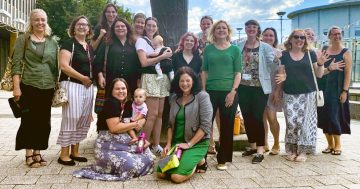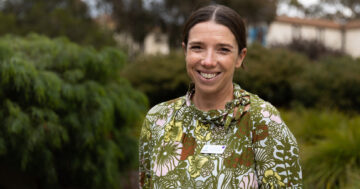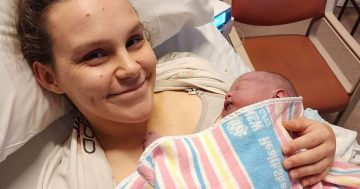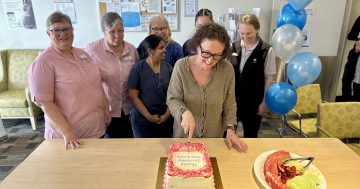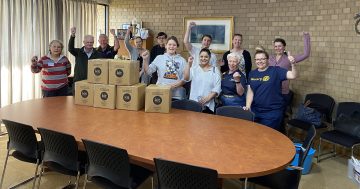
Anne Maree Maher’s (right) son Anthony (centre) was among the first babies born at Canberra Birth Centre. Since then, Anthony’s children Michael, Evelyn and Hazel have been born there too. Photo: Supplied, Anne Maree Maher.
It’s a moment truly breath-taking to witness: the second a baby arrives into the world and cries its first cry.
Canberra Birth Centre has seen more than 10,000 of these moments over the past 30 years, and now the people involved with the service want to celebrate.
Anne Maree Maher has been a midwife with the birth centre since 2003, but her journey there started in 1992.
Her second child Anthony, and subsequent children Michael and Dominic, were all born at the centre.
Her first son Peter only missed out because the centre wasn’t open when he was born.
“I felt safe there, it was a normal-looking bedroom but there was still equipment if you needed it,” Anne Maree said.
Canberra Birth Centre opened on 1 April, 1992, and Anthony was born on 15 May, making his among the first cries heard there.
Anthony and his partner have also brought all three of their children into the world at the centre.
“You don’t entrust that kind of care for your own children and grandchildren if you don’t believe in it,” Anne Maree said.
The birth centre was originally located on the ground floor of the maternity unit of the Woden Valley Hospital, before it moved onto level 3 of the Centenary Hospital for Women and Children in 2012, where it runs its Canberra Midwifery Program today.
It’s grown from three rooms to five, and now includes a home-birth program as part of its care model.
It’s a public service open to women living in Canberra, but has a waiting list due to its popularity.
Anne Maree said the continuity of care model from the midwives made expecting mothers and families feel more secure.
“Birth is a wellness, not an illness … if everything goes to plan, it’s a normal, physiological process,” she said.
“We know women who can access a continuity mode of care go into spontaneous labour more frequently and use less pain relief – not because it’s not offered but because it’s not needed.”
She said the continuity of care model meant women had the same midwife throughout their pregnancy journey, from the first appointment at about 12 weeks into pregnancy to postnatal visits until the baby was two weeks old.
This also meant continuity of information where mothers could request the same midwife the next time they fell pregnant.
“When someone comes back and asks for you to be their midwife again, you know you’re doing your job right,” Anne Maree said.
“It’s very rewarding for us as well. Yes, you get called out at all weird hours of the night, but you do it because you love it.”
Anne Maree said the centre should be made available to more women.
“I’d love to see more staff to take on more clients,” she said.
“Every women should be able to access a continuity midwife for all their pregnancy care.”
Women who start as a low-risk pregnancy but develop complications can still access continuity of care even if they can’t ultimately give birth at the centre.
The centre employs about 21 midwives; a full-time midwife will look after about 40 women each year.
Christine Fowler, who began work there in 1995, has managed the birth centre for the past few years. She’s also given birth through the centre’s program.
She hopes it can be expanded further to allow even more mothers to bring new life into the world.
“It would be lovely if it was available to everyone,” Christine said. “So we want to remind the Canberra community this is a very special place and really needs to be supported.
“I would love to see a free-standing birth centre run by midwives in Canberra in the future.”
She said while the beds may have been upgraded, water births were now more supported, and the location had changed, the centre’s philosophy remained the same.
“It’s women-centred care to provide continuity of care,” Christine said.
“It’s been fabulous to have been able to offer that care and service to the women of Canberra.”
A ticketed gala night will be held to celebrate the Canberra Birth Centre’s 30th anniversary at the Canberra Southern Cross Yacht Club on 10 November.












